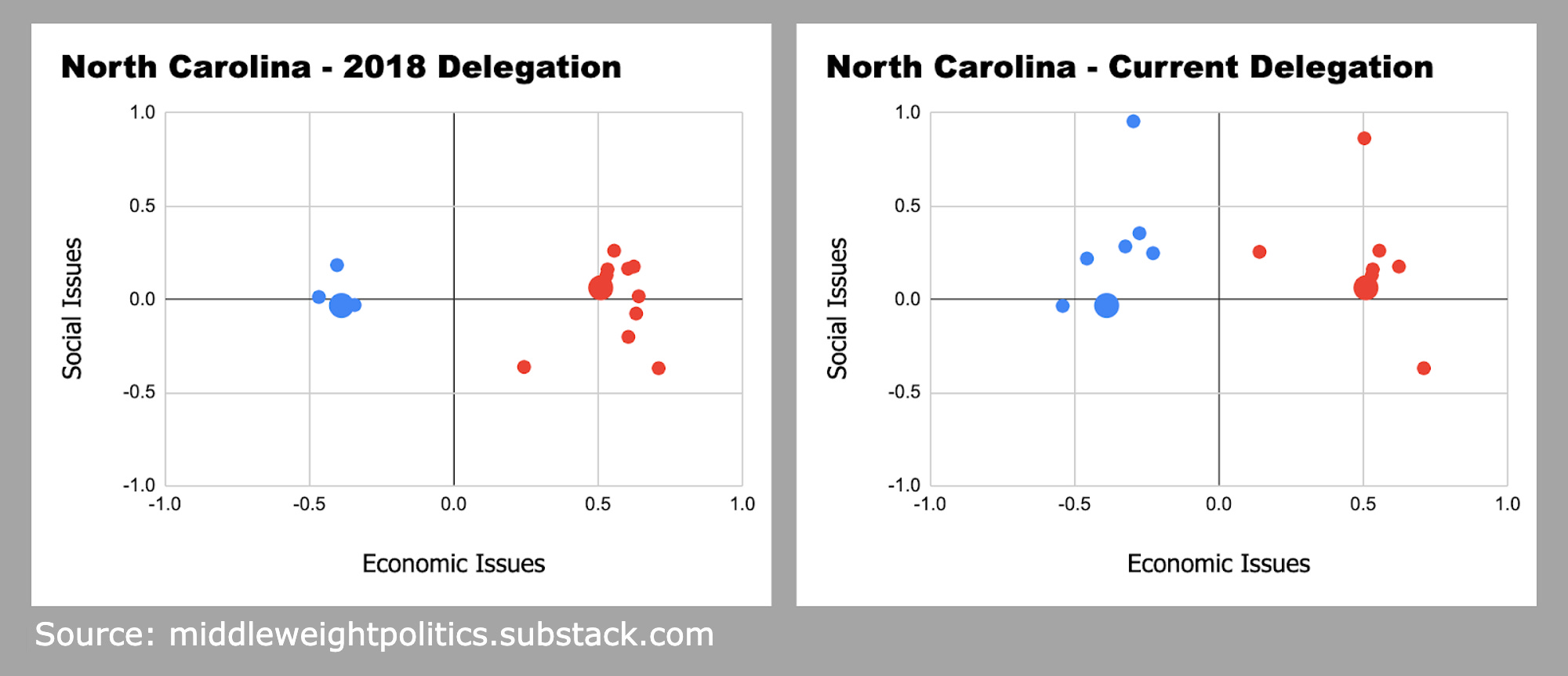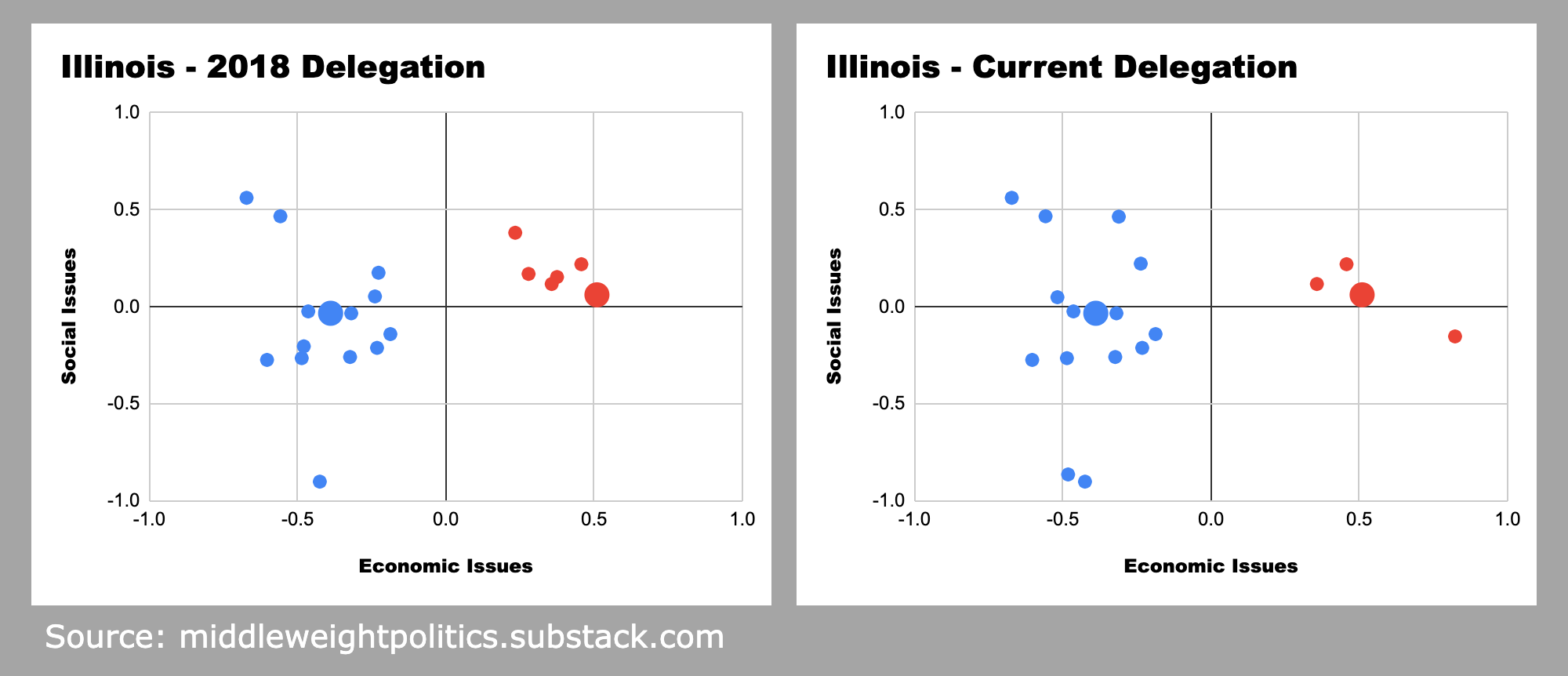Gerrymandering Reform: Are We Asking the Wrong Question?
Editor's Note: This article originally appeared on the Dan Sally's website and has been republished on IVN with permission from the author.
Earlier this month, Democrats scored a win when they picked up the seat left vacant by Cameo star and former Republican representative, George Santos. After the expulsion of Santos and the retirement of two additional House GOP members, Republicans can only lose two members to pass legislation on a party-line vote.
Logic would dictate that, in a representative democracy, House Republicans would seek common ground with moderate Democrats on important issues. This idea, of course, rests on the idea that logic dictates anything in the House or that we live in a representative democracy - both of which seem to be up for debate nowadays.
It would also assume there are enough moderate Democrats for Republicans to find common ground with.
As America’s two major parties have become more polarized, moderate members of Congress have become a dying breed, meaning fewer people willing to bridge the partisan divide to pass critical legislation.
Many have blamed gerrymandering for the rise in polarization, arguing the selective carving of districts to make them more tilted towards one party has made representatives less likely to negotiate with the other side.
The data show this is partly true, and also shows ending gerrymandering won’t solve the problem entirely. More importantly, two states show there may be a better option.
How the Gerrymander is Eating House Moderates
Since 2017, Princeton University’s Gerrymandering Project has issued report cards on the congressional maps of all 50 states - ranking them based on things such as compactness, contiguity, and partisan fairness.
For the most recent redistricting cycle, a quarter of the class failed.
North Carolina has historically ranked among the worst for gerrymandering. Despite having a roughly 50-50 balance in the popular vote for the last decade, about 75% of their congressional delegation has been Republican.
North Carolina’s General Assembly seemed poised to repeat its performance in the most recent redistricting cycle until the state’s supreme court threw the Republican-drawn map out and forced them to use a map that better reflected the state’s partisan balance. This earned North Carolina an A from Princeton and resulted in the election of a congressional delegation that was 50% Republican and 50% Democrat - just like the popular vote.
If we compare the ideological makeup of the state’s 2022 congressional delegation with that of 2018, we see the non-gerrymandered map had a moderating effect.
The chart below shows North Carolina’s 2018 congressional delegation on the left and the current one on the right, with two large dots representing the ideological average of both national parties. The chart’s X-axis shows how members voted on economic issues (left being more conservative and right being more liberal) and the Y-axis represents how they voted on social issues (bottom being most liberal and top being most conservative).

We can see that the 2022 map includes more Democrats to the right of their party ideologically, as well as one center-right Republican. In the gerrymandered map, those moderates are gone.
The same 2022 midterms that changed the partisan balance of North Carolina’s congressional delegation also changed the partisan balance of the state’s supreme court from majority Democrat to majority Republican. That new Republican-led court promptly reversed the court’s earlier decision, ruling the legislature had the authority to draw whatever kooky map it wanted.
And did they ever.
Three of North Carolina’s seven Democratic House members have opted to resign, rather than face reelection in a newly carved district where they’ll surely lose. Representatives Jeff Lewis, Kathy Manning, and Wiley Nickel each rank more conservative than 40% of House members - putting them right in the middle ideologically.
This isn’t something unique to Republican-led states either. We can see the same thing happened in reverse in Illinois, whose new gerrymandered map has also earned them a failing grade from Princeton.

In the case above, we see moderate Republicans were carved out of existence in the most recent redistricting cycle - the same type of Republicans who might be inclined to work with moderate North Carolina Democrats to break impasses over issues such as funding the government and addressing the current migrant crisis, were those moderate Democrats not also carved out of existence.
But the Gerrymander Didn’t Eat All the Moderates
While the information above makes a case for stopping the gerrymander, there are practical and legal hurdles to ending the practice. More importantly, by focusing exclusively on gerrymandering, we may be asking the wrong question.
The argument for ending gerrymandering assumes a fair congressional map is one where the proportion of ballots cast for a given party is reflected in that party’s share of a state’s congressional delegation. But is a fair congressional map one where the percent D’s and R’s in Congress line up with the percent of ballots cast or one where House members accurately represent the views of all the voters they serve?
With America’s winner-take-all system of elections, one voter can vote for one candidate, and one candidate can only represent one party. Candidates in competitive districts have to consider the views of those in the middle to win office, however, only around 20% of House districts are competitive, meaning neither party has a margin of over 5%.
The remaining 80% need to weigh the views of the median voter from their party rather than the median voter in their district, meaning most House members end up being more partisan than the voters they represent. This also means that a sizable chunk of voters end up having little influence over how their representatives vote in Congress.
To put that in numbers, a little under 26% of all ballots cast in safe districts in the 2022 midterms were cast for the losing candidate - meaning about 28 million voters have no real voice in the House. This number doesn’t include the 35 districts where candidates ran unopposed and presumably have minority party voters who’d cast ballots for someone else if given the option.
Research by the Cook Political Report shows almost 60% of the decline in competitive districts over the last 25 years can be attributed to a rise in rural/urban polarization, with the remaining 40% being due to redistricting/gerrymandering, so even the best redistricting reform would only address half the problem.
There are also more effective ways being used right now that can give these voters more influence over who makes it into Congress that are far less fraught.
An Easier Fix
In 2018, Maine implemented ranked-choice voting in federal elections. Where voters in most elections in America can only choose one candidate, ranked-choice voting allows voters to rank their candidates in order of preference - so if my first-choice candidate doesn’t win, I can still throw my support behind my second, third, or fourth choice.
Two years later, Alaska passed a top-four primary system where all candidates compete for all voters in an open primary. The top four vote-getters make it on the ballot in the general election, which is then determined by ranked-choice voting.
Both systems require candidates to consider the views of all the voters they serve, as even voters from the opposite party can push you to victory via their second or third-choice votes. More importantly, it also disincentivizes taking hard-line positions, as being too partisan could alienate a portion of the electorate.
In Maine and Alaska, these systems have produced members of Congress with an unusual focus on actually governing while in office, as opposed to the political performance art the House has become known for.
Alaska’s at-large congressional district is ranked with a +9 Republican advantage by the Cook Partisan Voting Index and one Trump won by 10%. Despite this, Democrat Mary Peltola won in a race against Trump-backed Sarah Palin.
While in office, she proposed forming a power-sharing agreement with Republicans as a way to break the impasse during Kevin McCarthy’s bid for Speaker of the House.
Democrat Jared Golden of Maine’s 2nd Congressional District - a district with a +6 Republican Advantage - recently said he’d protect Speaker Mike Johnson from the threat of a motion to vacate if the Speaker would pass legislation to keep the government open and provide aid to Ukraine.
Both states have also elected Lisa Murkowski and Susan Collins, the two most moderate Republicans in the Senate.
For the House to be a functioning body, legislators need to legislate. As America’s two major parties have drifted further apart ideologically and districts have grown more partisan, the incentives for House members to do their jobs have given way to the desire for their bases to stop the opposing party at all costs.
This being said, polling shows a vast majority of Americans would prefer that officials in Washington compromise than stand on principle. The bipartisan delegations of Maine and Alaska show this can happen if we give that same vast majority greater influence over who serves in Congress.








